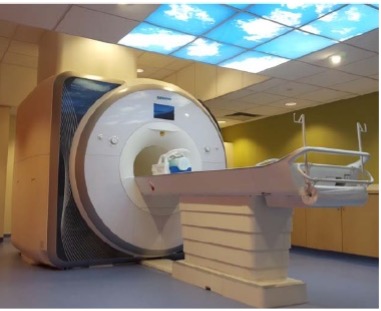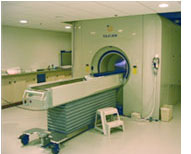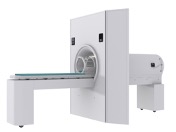


























 |
|

| |
Schedule an Appointment  Call 617-855-3385 Call 617-855-3385
(toll-free 1-877-940-8952)
Monday�Friday, 8:30 a.m.�
5:00 p.m. |
| |
 Fax: 617-855-3757 Fax: 617-855-3757 |
| |
|
The McLean Imaging Center supports three clinical whole body magnetic resonance scanners in the same building. A Siemens 3T Trio (32-channel head coil) and a Siemens 3T Prisma (64-channel head coil) scanner are used for both clinical diagnostic imaging and research while a Varian 4T scanner is used for research purposes only.
3T Siemens Prisma Scanner
 The MIC�s primary clinical and research scanner is a whole-body 3 Tesla Siemens Prisma high-field clinical scanner (Siemens Medical Solutions USA Inc., Malvern, PA) which became fully operational in April 2016. The Prisma is approved by the FDA for clinical use. It has full EPI/fMRI/DTI capabilities as well as proton and multinuclear spectroscopy and multiband EPI. The MIC Prisma features a 64-channel RF system for array coil and parallel imaging, and high speed, high power gradients (80 mT/m, 200 T/m/s slew) for efficient echo planar and diffusion tensor imaging. The SNR and the parallel imaging speed make DTI and fMRI attractive applications for this system. Additional options include the complete set of online and offline image processing and applications for head and neuroimaging methods including Simultaneous multislice (SMS, or multiband) EPI, Arterial Spin Labeling (ASL), PACE, Susceptibility Weighted Imaging, Dynamic Angiography (TWIST), patient positioning regularization, image field of view magnification (ZOOMit), and fast T2 anatomic techniques including BLADE and SPACE. In addition to all standard system coils, this system includes an optional 64 channel phased array head/neck receive coil and a Circular Polarized Transmit/Receive head coil, as well optional Body, Knee, Foot/Ankle, Wrist, and Shoulder coils. The system is also equipped with a dual tuned Proton/Phosphorous Transmit/Receive volume head coil from Rapid Biomedical. Because of our research agreement with Siemens, we have and use a number of research pulse sequences, including multidelay 3D pCASL for performing quantitative blood flow measurements, both the University of Minnesota and MGH Simultaneous Multislice (Multiband) echoplanar imaging sequences, and the enhanced spectroscopy pulse sequences and shim routines from the University of Minnesota. The MIC�s primary clinical and research scanner is a whole-body 3 Tesla Siemens Prisma high-field clinical scanner (Siemens Medical Solutions USA Inc., Malvern, PA) which became fully operational in April 2016. The Prisma is approved by the FDA for clinical use. It has full EPI/fMRI/DTI capabilities as well as proton and multinuclear spectroscopy and multiband EPI. The MIC Prisma features a 64-channel RF system for array coil and parallel imaging, and high speed, high power gradients (80 mT/m, 200 T/m/s slew) for efficient echo planar and diffusion tensor imaging. The SNR and the parallel imaging speed make DTI and fMRI attractive applications for this system. Additional options include the complete set of online and offline image processing and applications for head and neuroimaging methods including Simultaneous multislice (SMS, or multiband) EPI, Arterial Spin Labeling (ASL), PACE, Susceptibility Weighted Imaging, Dynamic Angiography (TWIST), patient positioning regularization, image field of view magnification (ZOOMit), and fast T2 anatomic techniques including BLADE and SPACE. In addition to all standard system coils, this system includes an optional 64 channel phased array head/neck receive coil and a Circular Polarized Transmit/Receive head coil, as well optional Body, Knee, Foot/Ankle, Wrist, and Shoulder coils. The system is also equipped with a dual tuned Proton/Phosphorous Transmit/Receive volume head coil from Rapid Biomedical. Because of our research agreement with Siemens, we have and use a number of research pulse sequences, including multidelay 3D pCASL for performing quantitative blood flow measurements, both the University of Minnesota and MGH Simultaneous Multislice (Multiband) echoplanar imaging sequences, and the enhanced spectroscopy pulse sequences and shim routines from the University of Minnesota.
3T Siemens Trio Scanner
 The MIC�s second high-field clinical scanner is a Siemens Trio 3T scanner (Siemens Medical Solutions USA Inc., Malvern, PA), installed in July 2003, and upgraded to a 32-channel TIM platform in September 2009. The Trio system is a whole-body 3T MRI system that is approved by the FDA for clinical use. It has full EPI/fMRI/DTI capabilities as well as proton and multinuclear spectroscopy and multiband EPI. The TIM Trio features a 32-channel RF system prepared for array coil and parallel imaging, and high-speed gradients (40 mT/m, 200 T/m/s slew) for efficient echo planar and diffusion tensor imaging. The SNR and the parallel imaging speed make DTI and fMRI attractive applications for this system. Additional options include the complete set of inline and offline image processing and applications for head and neuroimaging methods including Arterial Spin Labeling (ASL), PACE, patient positioning regularization, and fast T2 anatomic techniques including BLADE and SPACE. The 3T scanner time is primarily devoted to research. We have a Circular Polarized Transmit/Receive head coil, a 12 channel Receive coil, a 32 channel receive coil, a TIM spine coil with the ability to use anterior components for neck and abdominal imaging, large and small shoulder coils, and a Transmit/Receive knee coil. Because of our research agreement with Siemens, we also have and use a number of research pulse sequences, including dual echo pCASL for performing simultaneous BOLD/ASL experiments, and both the University of Minnesota and MGH Simultaneous Multislice (Multiband) echoplanar imaging sequence for very low TR/high spatial resolution EPI. The MIC�s second high-field clinical scanner is a Siemens Trio 3T scanner (Siemens Medical Solutions USA Inc., Malvern, PA), installed in July 2003, and upgraded to a 32-channel TIM platform in September 2009. The Trio system is a whole-body 3T MRI system that is approved by the FDA for clinical use. It has full EPI/fMRI/DTI capabilities as well as proton and multinuclear spectroscopy and multiband EPI. The TIM Trio features a 32-channel RF system prepared for array coil and parallel imaging, and high-speed gradients (40 mT/m, 200 T/m/s slew) for efficient echo planar and diffusion tensor imaging. The SNR and the parallel imaging speed make DTI and fMRI attractive applications for this system. Additional options include the complete set of inline and offline image processing and applications for head and neuroimaging methods including Arterial Spin Labeling (ASL), PACE, patient positioning regularization, and fast T2 anatomic techniques including BLADE and SPACE. The 3T scanner time is primarily devoted to research. We have a Circular Polarized Transmit/Receive head coil, a 12 channel Receive coil, a 32 channel receive coil, a TIM spine coil with the ability to use anterior components for neck and abdominal imaging, large and small shoulder coils, and a Transmit/Receive knee coil. Because of our research agreement with Siemens, we also have and use a number of research pulse sequences, including dual echo pCASL for performing simultaneous BOLD/ASL experiments, and both the University of Minnesota and MGH Simultaneous Multislice (Multiband) echoplanar imaging sequence for very low TR/high spatial resolution EPI.
Varian 4T Scanner
 In addition to the two clinical diagnostic scanners above, the Center is equipped with a research scanner � a 4T Varian scanner, which serves as the primary spectroscopy research scanner. In 2011, the scanner was upgraded to a new DirectDrive� console offering whole body magnetic resonance capabilities (Agilent Technologies, Palo Alto, CA). The DirectDrive� console has been redesigned for optimal performance by relying solely on digital technology to operate the high-powered RF and gradient amplifiers, as opposed to the old analogue Varian technology. This new digitally-driven system allows for much improved stability in real time RF waveform generation as well as signal reception and digitization resulting in greater signal-to-noise and signal fidelity. The upgraded scanner has eight 500 kHz RF receive channels allowing for the use of phased array coils for imaging and spectroscopy � further improving the sensitivity of the system. The high duty cycle body gradient set allows for rapid multi-slice echo planar imaging (35 mT/m, 220 �s risetime). The system has a wide variety of RF coils, including two quadrature transmit/receive proton head coils, a detunable transmit only proton head coil for use with surface coils, a number of dual tuned head coils, including proton/phosphorous, proton/carbon, proton/flourine, proton/lithium and proton/sodium, and various smaller, locally built coils. The 4T scanner is dedicated to 100% MR spectroscopy research. In addition to the two clinical diagnostic scanners above, the Center is equipped with a research scanner � a 4T Varian scanner, which serves as the primary spectroscopy research scanner. In 2011, the scanner was upgraded to a new DirectDrive� console offering whole body magnetic resonance capabilities (Agilent Technologies, Palo Alto, CA). The DirectDrive� console has been redesigned for optimal performance by relying solely on digital technology to operate the high-powered RF and gradient amplifiers, as opposed to the old analogue Varian technology. This new digitally-driven system allows for much improved stability in real time RF waveform generation as well as signal reception and digitization resulting in greater signal-to-noise and signal fidelity. The upgraded scanner has eight 500 kHz RF receive channels allowing for the use of phased array coils for imaging and spectroscopy � further improving the sensitivity of the system. The high duty cycle body gradient set allows for rapid multi-slice echo planar imaging (35 mT/m, 220 �s risetime). The system has a wide variety of RF coils, including two quadrature transmit/receive proton head coils, a detunable transmit only proton head coil for use with surface coils, a number of dual tuned head coils, including proton/phosphorous, proton/carbon, proton/flourine, proton/lithium and proton/sodium, and various smaller, locally built coils. The 4T scanner is dedicated to 100% MR spectroscopy research.
MRI Simlator
 In April 2016 a new MRI Simulator™ (Psychology Software Tools, Inc., Pittsburgh, PA) equipped with a 32-channel coil, is located 30 - 90 feet from all three clinical scanners. The simulator is equipped with the SimFX and MoTrak systems. The MoTrak System is used to train participants to remain still while �data are collected.� In these practice trials, a movie or song is played, and if a participant�s head moves (the motion range is determined by the investigator), the movie or song will stop. In addition, during the simulated scan, the SimFx simulates the ambient scanner sound and active scanning noise. Taken together, the MoTrak System and SimFx train participants prior to the actual scan, which will minimize artifacts due to head movement and subject anxiety due to environmental unfamiliarity. This simulator has a 60 cm circular bore, a realistic scanner body and patient table, and a stimulus presentation system. In addition, this system is used with many patient and research participants to help them adapt to the environment and ease any elements of claustrophobia; it is particularly useful with adolescents, geriatric and psychiatric disorder populations. In April 2016 a new MRI Simulator™ (Psychology Software Tools, Inc., Pittsburgh, PA) equipped with a 32-channel coil, is located 30 - 90 feet from all three clinical scanners. The simulator is equipped with the SimFX and MoTrak systems. The MoTrak System is used to train participants to remain still while �data are collected.� In these practice trials, a movie or song is played, and if a participant�s head moves (the motion range is determined by the investigator), the movie or song will stop. In addition, during the simulated scan, the SimFx simulates the ambient scanner sound and active scanning noise. Taken together, the MoTrak System and SimFx train participants prior to the actual scan, which will minimize artifacts due to head movement and subject anxiety due to environmental unfamiliarity. This simulator has a 60 cm circular bore, a realistic scanner body and patient table, and a stimulus presentation system. In addition, this system is used with many patient and research participants to help them adapt to the environment and ease any elements of claustrophobia; it is particularly useful with adolescents, geriatric and psychiatric disorder populations.
|